Sewage pipe as an important element of the sewer network:
What is a fan pipe, probably, knows anyone who at least once substantively engaged in the arrangement of sewage. However, superficial knowledge of this element is not enough, and therefore we recommend that you carefully study the information below. Then the drainage will be designed correctly, and the whole system will work "like a clock."
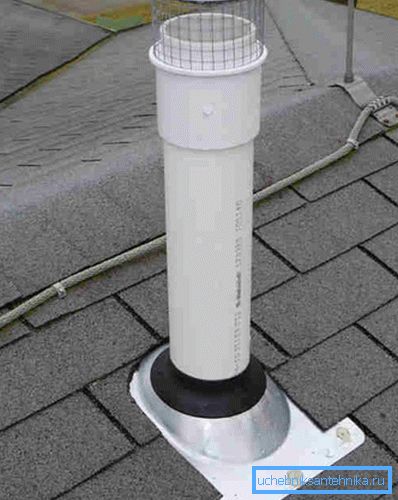
Why is it needed?
The sewage disposal system must operate according to certain rules. And one of these rules is the communication of all pipelines with the atmosphere to equalize pressure and ventilation. Fan pipes serve us for this very purpose.
Let's understand the functioning of this element in more detail:
- When draining is carried out, drains begin to move down the riser, and an air depression occurs in the upper parts of the pipeline.
- Partially, it is compensated for by the movement of water in the siphons, but with a one-time mass drain (for example, when we press the button on the toilet bowl), there may not be enough liquid to compensate for negative pressure.
- As a result, all the siphons above the riser are dried, and unpleasant odors of the sewage system begin to penetrate through the pipes. Of course, they can be blocked with a regular portion of water, but until the next use of the taps, the “aroma” will spread throughout the premises almost unhindered.

This problem is solved by installing a special pipeline, which is called the funnel. It ensures that the required amount of air enters the system, while the pressure surge does not occur and the siphons are not emptied.
The instruction recommends the installation of this element:
- In single-storey buildings, equipped with a riser with a diameter of not more than 50 mm.
- In the two-story buildings, if on the second floor there are sanitary appliances, which are the source of sewer water.
- In apartment buildings.
- In houses with pools, saunas and other structures, which are characterized by "salvo" drain a large amount of water.
At the same time, a fan pipe in a private house with a fairly powerful riser (110 mm) is by no means mandatory. If the sum of the diameters of all drains is smaller than the diameter of the riser, then its installation can be waived: the flow of water will still not be able to block the entire lumen of the pipeline.
Note! Ventilation of a septic tank without a funnel pipe is also unlikely to work the way we need it: even in the case of a partial biological treatment of effluent, odors will spread.
Mounting technique
Pipe installation
Installation or replacement of the funnel pipe in the apartment is usually carried out directly in the repair process. This is due to the high labor-intensiveness of the process, as well as to the large amount of destruction that accompanies it: the dimensions of the funnel are such that the holes in the ceilings will have to be rather large.

By itself, the detail is a continuation of the riser, and it can be mounted from the most simple materials.
Another thing is that the selection of elements and their installation should adhere to a number of rules:
- Ideally, the diameter of the funnel pipe should coincide with the diameter of the riser (it is best to take 110 mm in both cases). So we will not only ease our lives during installation by refusing adapters, but also guarantee pressure equalization.
- The outer part of the pipeline must be placed in such a way that the outgoing air disperses as quickly as possible and the unpleasant smell does not spread.. For this reason, the fan pipe in a multi-storey building is usually displayed on an open roof, and in a private household it is located farther from the neighboring plots.
- It is also very important to observe the correct temperature ratio: the lower part of the pipe must necessarily be in a heated room, and the upper part - in the cold. Only in this case the direction and speed of air movement in the system will be optimal.
Tip! Placing output in the attic is strictly prohibited!
The installation process itself for a more or less experienced wizard is not difficult:
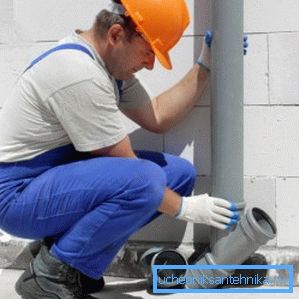
- As the material, we take either cast iron or plastic pipe. Cast iron is characterized by a high price and a very substantial mass, but such a construction is practically “eternal”. On the other hand, plastic is easier to process, because beginners should choose this option.
- Begin installation from the bottom mounting point located in the riser or on the foundation.
- The fan pipe is laid strictly vertically, fixing to the supporting structures with hose clips on anchors.
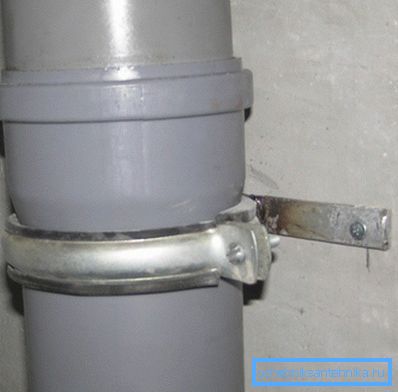
- After the work is completed, we install an adapter with a tap for a washing machine (if needed) and a toilet bowl.

- In some cases (when the riser passes in the immediate vicinity of the residential premises) noise isolation may be required. It is easiest to implement using spraying polyurethane foam or arranging the casing of polystyrene foam.
Check valves
Describing the installation process of the system, it is impossible to ignore such an element as a check valve.
This part performs a number of functions:
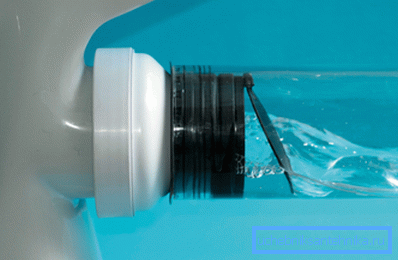
- First, the valve prevents the return movement of drains, blocking water from entering the drain, feces into the toilet, etc.
- Secondly, the device prevents the return to the system of mechanical particles that can lead to breakage of valves.
- Thirdly, thanks to the valves on the sewer system rodents can not move, and in the southern regions - and reptiles.
- Finally, the installation of such a part contributes to the equalization of pressure in case of errors in the laying of pipes: partial compensation for insufficient slope is quite possible.

By design, the valves are divided into internal and external:
- The internal valve is mounted using a special insert, which is placed in the lumen of the pipe. To install the item degreased and cleaned, then placed in the selected location. Now, with the passage of wastewater, the valve leaf opens, and in their absence remains closed.
Tip! The internal valve is mounted without the use of silicone lubricants and sealants - only "dry"!
- The outdoor model operates according to a similar principle. For its installation in the pipeline, a special adapter is installed.
Removal of the ventilation duct
Do-it-yourself installation of a fan system also provides for installation of an outlet vent pipe.
Here it is worth adhering to such recommendations:
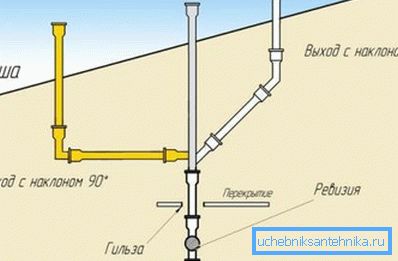
- For a flat unexploited roof, the size of the ventilation part must be at least 50 cm. The higher the ridge roof ridge, the longer the pipe must be on it.
Tip! If in your area strong winds blow or a large amount of snow falls, in advance take care of strengthening of a ventilation conclusion with extensions.
- If the roof is actively used or used, for example, for growing plants, then the vent pipe must be raised by at least 3 m.
- The withdrawal of the funnel pipeline cannot be combined in one casing with the ventilation duct or chimney.
- If open windows or balconies are located nearby, then the minimum distance from them to the pipe cut is 4 m.
The design itself does not provide for any additional accessories that facilitate the hood. It is also undesirable to install baffles or similar devices, since they lead to the formation of condensate and to a decrease in permeability.
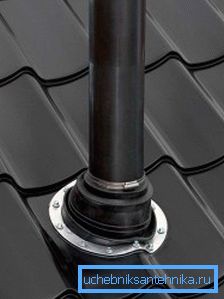
In exceptional cases, the removal of the funnel pipe through the wall is allowed, but here the SNIP requirement comes into effect, according to which it will still be necessary to raise the nozzle above the roof level. So, the outer segment should be made quite long, fixing it reliably on the supporting structures.
Conclusion
A sewer pipe is an almost mandatory element. You can do without it only in one-story houses, but even there you should think about solving the problem of unpleasant smell. Installation of such a device is associated with significant labor costs, so it is best to perform it together with the installation of the drainage system itself. The technology used is described in more detail in the video in this article.